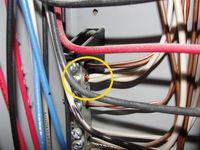While I try to make most of my blog posts somewhat generic and appealing to most, this one ain't that. This post is about a very specific electrical defect that I frequently run across, and I'm writing this post so I can give my clients a better explanantion of this defect. Oh, and also so I can give my clients proof that this isn't some new requirement that I just heard about.

One reason that two neutral wires can't be connected to a single terminal in a panelboard is so that the circuit can be isolated if it needs to be worked on. There is a great explanation of this at the Schneider-Electric web site. The other reason you can't have two neutral wires connected under a single lug is because the connections might come loose. While panel manufacturers will allow for up to three grounding conductors under a single lug, they typically only allow one neutral wire. The grounding conductors aren't going to normally carry current for extended periods of time, so they have a very slim possibility of coming loose. This isn't the case with the neutral conductors.
Despite what many seem to think, this didn't become a new requirement in 2002. This has been a requirement of UL 67 for a long time, but was spelled out in the NEC in 2002. Oh, and for the record, if a home inspector recommends a repair of say, a double tapped neutral, they're doing it for the reasons listed above; not because it's "code".

